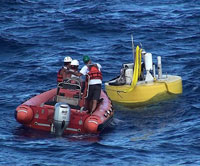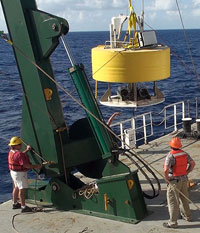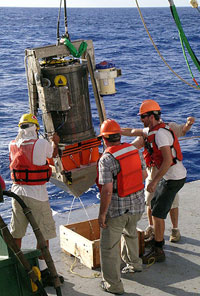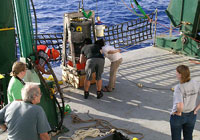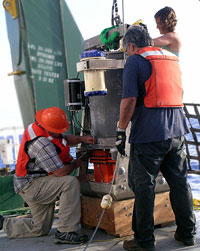- C-MORE Home
- What is Microbial Oceanography?
- What is C-MORE?
- Research
- • Research Cruises
- » BioLINCS
- Home
- Cruise Participants
- Instruments Used
on the Cruise - Nitrogen Cycling
- Marine Microbes
- Cruise Blog
- Data Archive
- Education & Outreach
- People
- Publications
- Image Library
- Contact Us
| |||||||||||||||||||||||||||||||||||
BioLINCS Cruise Blog
Sunday, September 18, 2011
|
Crew members from the Kilo Moana took a small boat into the open ocean to install a lifting strap on the yellow float for the Environmental Sample Processor (ESP). The ESP’s original lifting line became wrapped around the cable that runs between the float and the instrument, 25 meters below the surface. |
|
Because the lifting line for the ESP became wrapped around its underwater cable, both the lifting line and the cable had to be cut before the float could be brought safely on deck. |
|
After overcoming many challenges, the crew of the Kilo Moana and the ESP team managed to recover the ESP by late afternoon. |
|
The human molecular biologists on board the Kilo Moana gathered around the ESP to inspect their “competition”—an underwater robot that carries out some of the same gene analyses as they do in the lab. |
|
The ESP team, Gene Massion, Roman Marin III, and Julie Robidart, worked on the instrument after it was brought back on deck. |
Today started off pretty quiet, with most of the sediment trap team still walking around a little zombie-like, while finishing up their analyses and preparation of the samples they collected yesterday morning. But others, such as Kendra, Julie, and the MIT team, were busy with new incubation experiments on the upper deck.
We all knew that the big excitement was scheduled for this around two o’clock this afternoon, when the Environmental Sample Processor (ESP) was to be brought back on board the ship. This is by far the most complicated robotic system that we are using on this cruise. According to some researchers, it is the most complicated underwater robotic microbiology system in use anywhere [Craig Taylor’s Incubating Productivity System (IPS) may be the second most complicated].
The drifting ESP also has a complicated (and heavy) mooring system, which makes it tricky to deploy and recover in the best of conditions. Conditions were actually not bad today, with moderate trade winds of maybe 15 knots, scattered clouds, and the occasional “liquid sunshine,” as brief trade-wind showers are sometimes called in Hawai&isquo;i.
However, things are not always as simple as one would hope. Before recovering the ESP, the captain did a “drive by” with the Kilo Moana. Using binoculars, we could see that the bright yellow recovery line and red floats had wrapped around the big yellow surface float, presumably because the waves had caused it to gradually rotate as it drifted across the ocean. We had looked for signs of this rotation during our previous drive-by examinations, but had not seen any.
Because the recovery line was wrapped around the float, there was no easy way to grab hold of the mooring from on board the ship. After some deliberation, the captain decided to lower three men into the sea in an rigid-hulled inflatable boat to go lasso the float, and attach a lifting line to it. Getting the boat the three guys in the water looked dicey to me, what with the choppy seas. But once in the water, the guys went right to work.
They headed over to the float and spent quite a bit of time getting the recovery line unwrapped from the float. Unfortunately, about three quarters of the line had wrapped around the underwater part of the mooring, below the float. After doing the best job they could, the small-boat crew attached a lifting harness to the top of the float.
As the boat and float drifted on the waves, the captain of the Kilo Moana steered the ship up next to the ESP. The boat crew passed lines to the crew on the ship, and the yellow float was brought around to the stern of the Kilo Moana. The lifting harness was attached to a winch on the ship’s “A-frame” (the big metal arch that swings out over the stern of the ship), and the ESP float was lifted up against the stern of the ship.
At that point, we realized that the rotation of the float had been far worse than we thought. The yellow recovery line had wrapped tightly around both the rope lifting line and the wire data-cable that connect the float to the ESP.
There was no way we could bring the heavy, 2-meter-wide float on deck and recover the ESP safely with all of this mooring line wrapped around the wire cable. So Gene Massion took out a knife and cut off the part of the mooring line that was already on deck. Then, with the float hanging over the transom of the ship, he and the ship’s first mate slowly unwrapped the rest of the mooring line from the hanging cable, one wrap at a time, using a boat hook and some tricky rope handling.
Finally they unwrapped and cut off the last bit of mooring line, and the crew began to haul the float onto the ship. At that point, they discovered that the wire data-cable had twisted and kinked, wrapping itself around the rope lifting line. After much fruitless effort and consternation, out came the bolt cutters, and Gene cut through the expensive data cable, leaving the ESP hanging by its rope lifting line.
At last they were able to transfer the float to the ship’s crane and lift the float up onto the deck. Everyone breathed a small sigh of relief. But that was not the end of our bad luck. As they started to lift the ESP up from the depths, a shackle (a thick metal connector on the lifting line) became jammed in one of the blocks (pulleys) at the top of the A-frame.
So there we were, with the ESP hanging from a piece of rope that was stuck to the A-frame, 25 feet above our heads. For an hour or so, the crew tried various schemes to free the shackle, using ropes, cranes, and even an anchor capstan , but the shackle would not budge.
Finally someone hit on the idea of transferring the lower part of the ESP lifting line to a second pulley on the A-frame. After rigging a new line through the pulley, and quite a bit of effort to transfer the weight of the ESP to the new line, the recovery went pretty smoothly. The crew had the ESP on deck, safe and sound, just in time for dinner.
It was a long, hot afternoon, especially for Gene, Roman Marin, and the deck crew. Also for the guys bouncing around in the small boat, who had to wait until after the ESP came on deck before they could be lifted back up on board the ship. But no one was hurt, and all of the important equipment made it back on board, safe and sound. That’s what counts in the long run.
There were a lot of tired, sweaty people at dinner tonight, but the mood was relatively relaxed. People were talking about what they would do when they got back to shore. Tomorrow we’ll pick up Craig’s instruments and do a number of CTD casts. But most of these casts will simply use the electronic instruments on the CTD to make profiles of the water column rather than collecting water samples. The on-deck incubations are starting to wind down. The end is in sight.
[ Top of Page ]

